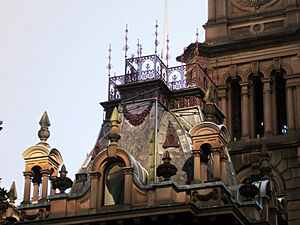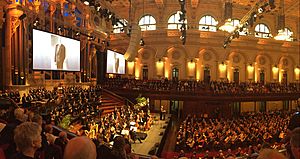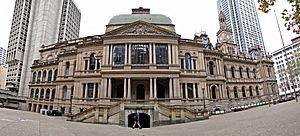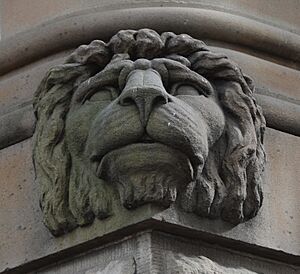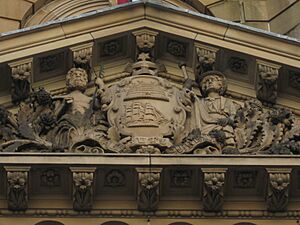Sydney Town Hall facts for kids
Quick facts for kids Sydney Town Hall |
|
|---|---|
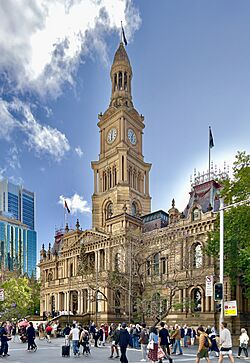
The Sydney Town Hall.
|
|
| Alternative names | Town Hall, Centennial Hall, Main Hall, Peace Hall, Great Hall, Old Burial Ground |
| General information | |
| Status | Complete |
| Type | Town hall |
| Architectural style |
|
| Location | 483 George Street, Sydney CBD, New South Wales |
| Country | Australia |
| Coordinates | 33°52′24″S 151°12′23″E / 33.873235°S 151.206323°E |
| Construction started | 1869 |
| Opened | 1878 (first stage) 1890 (second stage) |
| Renovated | 1991–92 |
| Renovation cost | A$15.5 million |
| Owner | Council of the City of Sydney |
| Technical details | |
| Material |
|
| Floor count | 2 |
| Lifts/elevators | 1 |
| Design and construction | |
| Architect | John H. Wilson |
| Other designers |
|
| Main contractor |
|
| Known for |
|
| Other information | |
| Seating capacity | 2,535 (Centennial Hall) |
| Official name | Sydney Town Hall; Town Hall; Centennial Hall; Main Hall; Peace Hall; Great Hall; Old Burial Ground |
| Type | State heritage (built) |
| Criteria | a., b., c., d., e., f., g. |
| Designated | 5 March 2010 |
| Part of | Town Hall / QVB Group |
| Reference no. | 1452 |
| Type | Council Chambers |
| Category | Government and Administration |
The Sydney Town Hall is a beautiful old building in the city of Sydney, Australia. It was built in the late 1800s and is a very important historical site. A town hall is where the local government, like the Lord Mayor of Sydney and the city council, works. They hold meetings and events there.
You can find the Sydney Town Hall at 483 George Street. It's right across from the Queen Victoria Building and next to St Andrew's Cathedral. It's also above the Town Hall train station. The steps of the Town Hall are a popular spot for people to meet up.
Many architects like John H. Wilson and George McRae helped design this grand building. It was built between 1869 and 1889 by several construction companies. The Town Hall is also known by other names like Centennial Hall or Great Hall. It's listed on the New South Wales State Heritage Register, which means it's a very important historical place.
Interestingly, the Town Hall was built on top of an old cemetery. In recent years, the building has been updated to improve its systems. This included removing a lot of sandstone from underneath!
Contents
History of Sydney Town Hall
Built on an Old Cemetery
The Sydney Town Hall stands on what used to be the Old Sydney Burial Ground. This was Sydney's first official cemetery, used from 1792 to 1820. It's thought that at least 2,000 people were buried there. This included everyone from convicts to important citizens.
After the cemetery closed in 1820, it fell into disrepair. Many grave markers disappeared. When the Town Hall was built, some remains were moved to Rookwood Cemetery. However, many graves were left untouched beneath the building. Even today, sometimes old remains are found during construction work around the Town Hall.
Building the Town Hall
The city government, called the City Corporation, needed a proper place to meet. After many years, they were given the old burial ground site. The foundation stone for the Town Hall was laid in January 1868. The goal was to create a building that showed off Sydney's wealth and importance.
The building was constructed in two main parts. The first part, including the offices and council chambers, was finished in 1878. The second part, which included the large Main Hall, was completed later in 1890. The design was chosen through a competition, won by J. H. Willson. The building's style was inspired by grand French buildings.
Important Events and Changes
From the late 1880s to the 1890s, the Town Hall was a key place for meetings about the Federation of Australia. This is when the different Australian colonies decided to join together to form one country. Both supporters and opponents of federation held big meetings here.
Over the years, the Town Hall has seen many changes and updates. In the early 1900s, the interior was redecorated. During World War I and World War II, the Town Hall played an active role. It was used for public safety and to boost morale.
Before the Sydney Opera House opened, the Town Hall was Sydney's main concert hall. It also hosted important guests, including royalty. In the 1950s and 60s, it was used for citizenship ceremonies and public health events. Later, in the 1970s, its steps became a popular spot for protests and demonstrations.
Major restoration work happened in the early 1990s. In 2000, the Sydney Town Hall was part of the Olympic and Paralympic events. Today, it continues to be a central place for city life and government.
What Does Sydney Town Hall Look Like?
The Sydney Town Hall is made from local Sydney sandstone. It's built in a grand style called Victorian Second Empire, which looks a bit like the Hôtel de Ville in Paris. People often describe it as having "lavishly ornamented composition with focal tower and fanciful roofs." This means it's very decorated with a main tower and fancy roofs.
The building has four main levels: Lower Ground, Ground, First, and Second floors. It also has some smaller levels around the stage and organ.
Inside the Town Hall
The Town Hall houses the Sydney City Council Chamber, where council meetings happen. It also has reception rooms and offices for the Lord Mayor of Sydney and councillors.
The Main Hall is the biggest room in the building. It's three storeys tall! At one end is a stage and the famous Sydney Town Hall Grand Organ. This organ is one of the largest in the world. It has a special 64-foot pipe, which is very rare. Before the Sydney Opera House, this hall was the main place for concerts in Sydney.
The Vestibule is another important space. It's a fancy two-storey area with an oval-shaped glass dome at the top. This area connects to the main entrance on George Street.
Building Materials and Design
The outside walls and decorative parts of the Town Hall are made from Sydney "yellowblock" sandstone. Inside, the walls are made of brick and plaster. The floors are made of timber, concrete, or tiles. The roof structures are mostly timber, but the Main Hall has huge steel beams.
The windows and doors are made from beautiful cedar timber. Many windows feature stained glass and leadlight glass. These windows often show Australian plants and animals, which was a very early use of local designs in architecture.
Decorations and Art
The inside of the Town Hall is very detailed and decorative. The Vestibule, for example, was originally painted with many different colours and finishes. These included fake marble and polished plaster.
The decoration changed over time. The later parts of the building, like the corridors and Main Hall, were designed to be less ornate. However, they still have a polished finish.
Condition and Importance
The Sydney Town Hall is in excellent condition today. It regularly undergoes cleaning and restoration to keep it looking great for the future. It has also been updated to be more environmentally friendly, with smart lights, better insulation, and solar panels.
Archaeological Importance
The land under the Town Hall is very important for archaeology. Because it was Sydney's first cemetery, it holds clues about the health and lives of early settlers. When construction work happens nearby, old graves are sometimes found. This helps researchers learn more about Sydney's past.
Why is it Important?
The Sydney Town Hall is very important for many reasons:
- City Center: It's still the main place for the City of Sydney council and where important decisions about the city are made.
- Landmark: With its clock tower and grand steps, it's a famous symbol of Sydney.
- Architecture: It's a fantastic example of the Victorian Second Empire style, with its fancy towers, domes, and detailed decorations. It shows amazing craftsmanship.
- Historical Site: The building's growth reflects how Sydney grew and became more important.
- Archaeology: The site's past as the Old Sydney Burial Ground gives it huge historical and scientific value. It helps us understand early Australian history.
- Community Hub: It has a high social value for everyone. It's used for big city events, concerts, and even political protests.
The Sydney Town Hall was officially listed on the New South Wales State Heritage Register in 2010. This means it's protected and recognized as a very special part of Australia's history.
See also
 In Spanish: Ayuntamiento de Sídney para niños
In Spanish: Ayuntamiento de Sídney para niños






